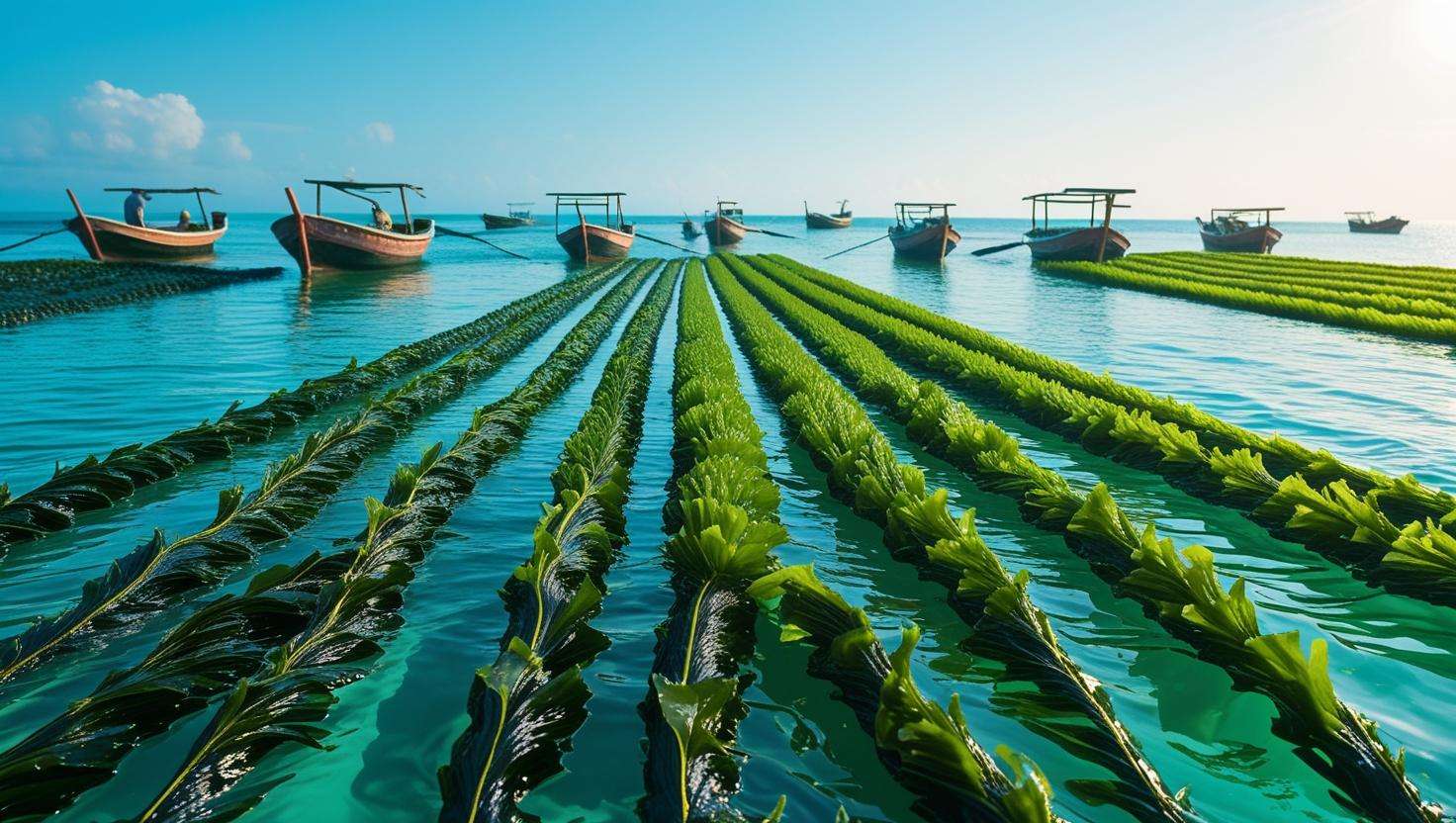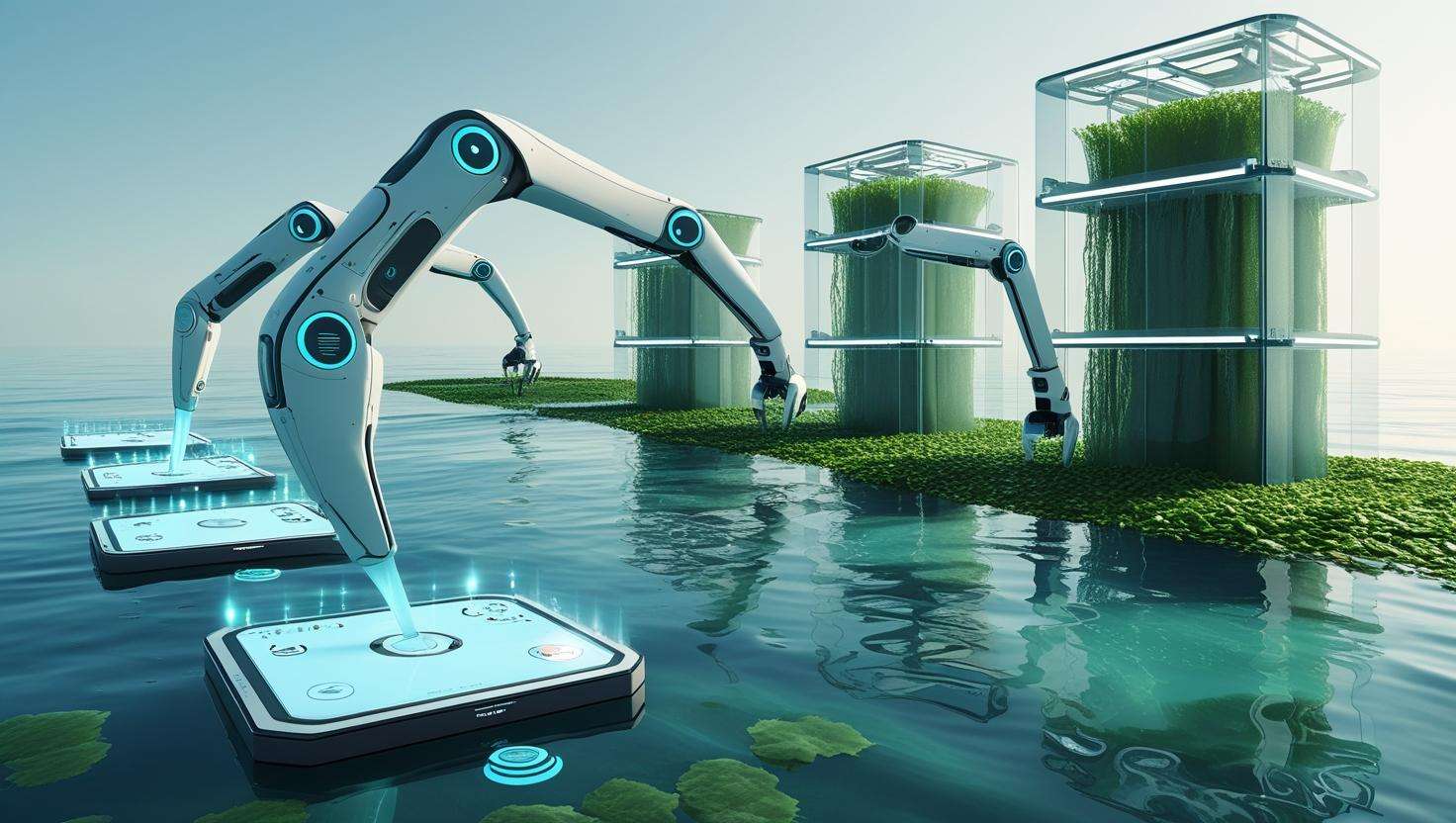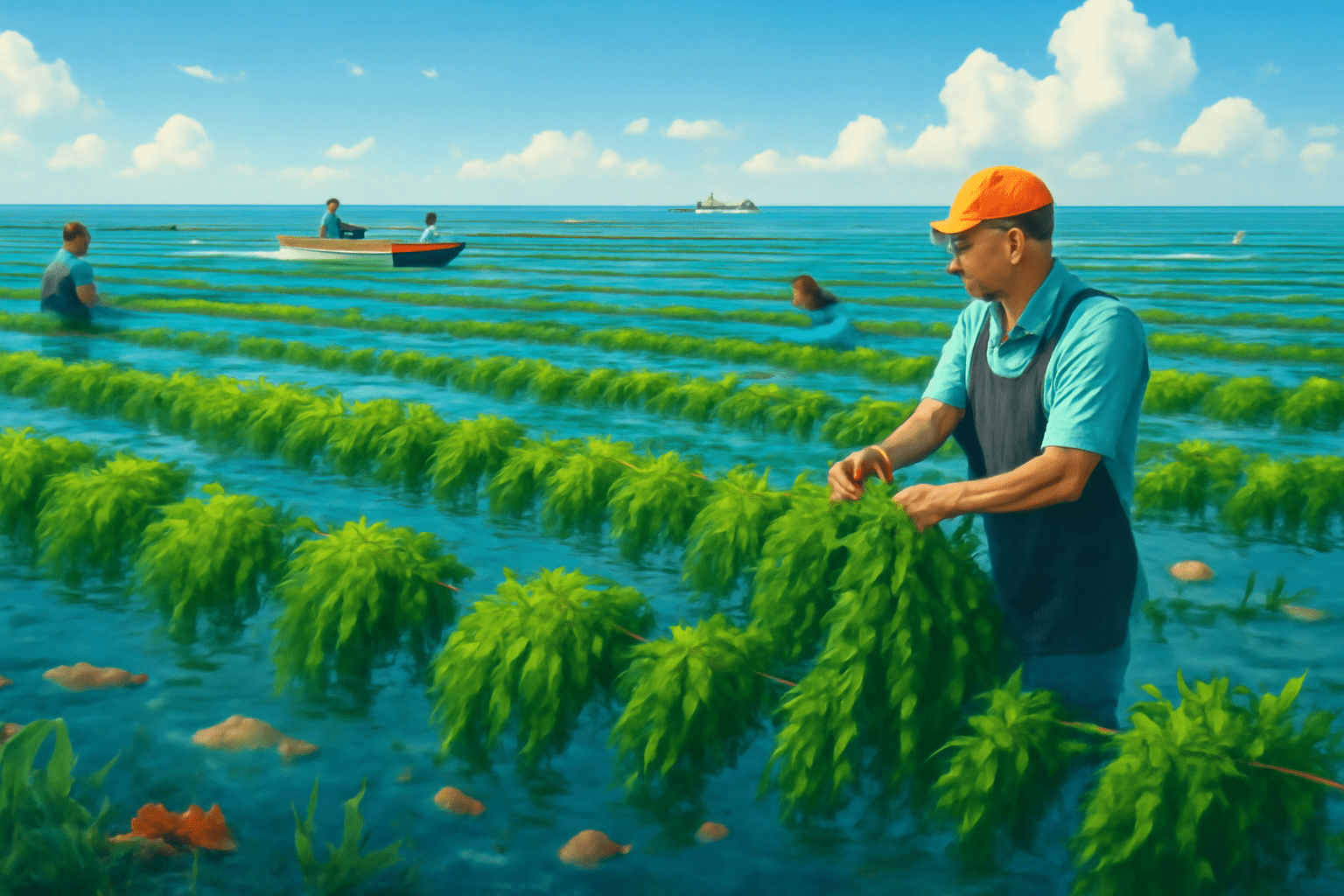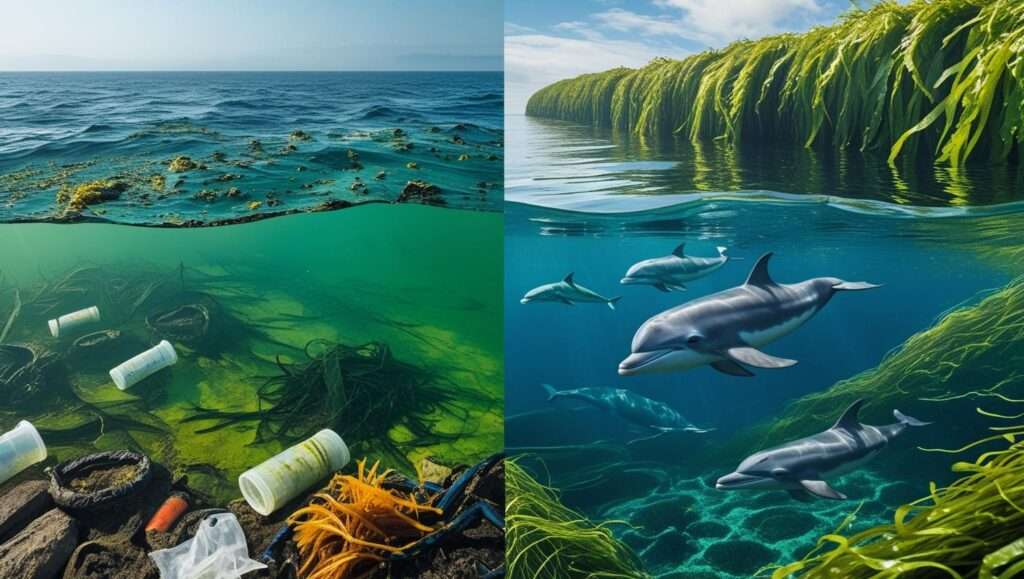 What if the answer to climate change, food insecurity, and plastic pollution was growing quietly beneath the waves?
What if the answer to climate change, food insecurity, and plastic pollution was growing quietly beneath the waves?
In a world facing rising temperatures, shrinking farmland, and oceans choking with waste, finding a sustainable solution for our planet has never been more urgent. While headlines often spotlight electric cars or solar panels, a lesser-known hero is making waves in the sustainability world—seaweed farming. This ocean-based practice is transforming how we think about agriculture, climate action, and environmental protection. It doesn’t need land, freshwater, or fertilizers, yet it captures carbon, boosts marine biodiversity, and creates green jobs in coastal communities 
 1. What is Seaweed Farming?
1. What is Seaweed Farming?
Seaweed farming—also known as seaweed cultivation or mariculture—is the process of growing seaweed in controlled marine environments. Unlike traditional agriculture, it doesn’t require land, freshwater, or chemical fertilizers. Instead, it thrives naturally in oceans, making it a low-impact, high-benefit practice for people and the planet  .
.
 What Exactly Is Seaweed?
What Exactly Is Seaweed?
Seaweed is a type of marine algae that grows in oceans and coastal waters. It comes in three main colors:
 Green (e.g., Ulva or sea lettuce)
Green (e.g., Ulva or sea lettuce)
 Brown (e.g., Kelp, Wakame)
Brown (e.g., Kelp, Wakame)
 Red (e.g., Nori, used in sushi)
Red (e.g., Nori, used in sushi)
These ocean plants are packed with nutrients and have been used for food, medicine, fertilizer, animal feed, and even biofuel for centuries.
 How Does Seaweed Farming Work?
How Does Seaweed Farming Work?
Seaweed farming is surprisingly simple—and scalable. Here’s a beginner-friendly breakdown:
 Step-by-step Overview:
Step-by-step Overview:
- Site Selection
Choose clean, nutrient-rich coastal waters with good water flow. - Seeding the Lines
Small fragments of seaweed (called seedlings) are attached to ropes or nets. - Deployment in the Water
The seeded lines are suspended in the sea using buoys and anchors. - Growth and Monitoring
Seaweed grows naturally by absorbing sunlight and nutrients from the water—no extra inputs needed! - Harvesting
After 45–90 days, farmers harvest the seaweed and prepare it for drying, processing, or selling.
This can be done in shallow coastal zones (nearshore farming) or deeper waters (offshore farming), depending on resources and regulations.

 Where is Seaweed Farming Popular?
Where is Seaweed Farming Popular?
Seaweed farming is booming worldwide. Top producers include:
 China – The largest seaweed farming industry in the world
China – The largest seaweed farming industry in the world
 Indonesia – A major exporter of red seaweeds like Eucheuma
Indonesia – A major exporter of red seaweeds like Eucheuma
 South Korea – Known for high-tech kelp and laver production
South Korea – Known for high-tech kelp and laver production
 Philippines – Vital for rural livelihoods and coastal communities
Philippines – Vital for rural livelihoods and coastal communities
 Norway &
Norway &  USA (Alaska) – Emerging hubs for sustainable seaweed startups
USA (Alaska) – Emerging hubs for sustainable seaweed startups
And interest is growing in Africa, Europe, and Latin America—making it a global green revolution in the making.
 Why Should You Care?
Why Should You Care?
Here’s the real value: Seaweed farming offers an accessible, eco-friendly way to fight climate change, create green jobs, and protect our oceans—all at once.
Whether you’re an environmentalist, coastal entrepreneur, policymaker, or student, seaweed farming is:
2. Why Seaweed Farming is a Sustainable Solution for Our Planet 
Seaweed farming isn’t just good for your health—it’s an essential tool in the fight against climate change and environmental degradation. Here’s why seaweed farming is one of the most sustainable solutions we have for protecting our planet. 
2.1. Absorbing Carbon Dioxide and Fighting Climate Change 
One of the biggest environmental challenges today is rising carbon dioxide (CO2) levels in the atmosphere, which contribute to global warming. Seaweed is a natural carbon sink, meaning it absorbs CO2 from the water and air as it grows. In fact, seaweed can absorb up to five times more CO2 than land-based plants! 
By growing seaweed in large quantities, we can help reduce the carbon footprint of our oceans and combat climate change. Plus, when seaweed is harvested and processed, it stores the carbon it absorbed, preventing it from being released back into the atmosphere. 
2.2. Improving Water Quality and Reducing Ocean Acidification 
Seaweed doesn’t just help the atmosphere—it also plays a vital role in improving ocean health. As seaweed grows, it absorbs excess nutrients, like nitrogen and phosphorus, from the water. These nutrients are often pollutants from agricultural runoff, which can lead to harmful algal blooms that suffocate marine life. 
Additionally, seaweed helps to combat ocean acidification, a result of rising CO2 levels. By absorbing CO2, seaweed helps maintain the balance of ocean pH, which is crucial for marine ecosystems to thrive. In short, seaweed farming is like an ocean cleanser, improving water quality and restoring balance to marine environments.

2.3. Supporting Marine Biodiversity 
Seaweed farming also provides an artificial reef-like structure that supports a variety of marine life. Fish, crabs, and other species use seaweed as shelter and food, promoting biodiversity in the area. This type of farming encourages healthy ecosystems by offering a safe habitat for marine organisms, which is especially important in regions where natural habitats have been damaged or destroyed.
In addition, seaweed farms can reduce coastal erosion by acting as natural barriers that protect shorelines from strong waves and storms. 
2.4. Minimal Environmental Impact 
Unlike traditional farming, seaweed farming has a very low environmental impact. It doesn’t require fresh water, pesticides, or fertilizers. No land is needed, which means seaweed farming doesn’t contribute to deforestation or loss of habitats. It’s a zero-waste practice, as every part of the seaweed can be utilized for different products—whether it’s food, cosmetics, or even bioplastics.
3. The Impact of Seaweed Farming on Biodiversity and Ecosystem Restoration 

Seaweed farming does more than just provide a sustainable source of food and materials—it has a profound positive impact on marine biodiversity and ecosystem restoration. By creating new habitats and promoting healthier oceans, seaweed farms are helping to revive our planet’s ecosystems. Here’s how:
3.1. Creating Habitat for Marine Life 
Seaweed farms act as artificial reefs, providing shelter and food for various marine species. These farms offer a safe environment for fish, crabs, and other organisms to live and grow. As seaweed grows and spreads, it forms dense mats or “forests” in the water, which create complex structures that fish and invertebrates can hide in. 
This added biodiversity helps improve the resilience of marine ecosystems, making them more adaptable to climate change, pollution, and overfishing. The lush seaweed “forests” offer critical shelter, supporting healthy populations of marine species. 
3.2. Supporting Coral Reef Restoration 
Coral reefs are vital for marine life, but they’re under threat from rising ocean temperatures, pollution, and destructive fishing practices. Seaweed farming can play a key role in restoring these critical ecosystems. When seaweed is planted near degraded coral reefs, it helps to stabilize the water quality, reduce excess nutrients, and provide a cleaner, healthier environment for coral to thrive. 
In some cases, seaweed farming can help reduce the effects of coral bleaching, allowing coral reefs to recover from stress and continue supporting the diverse marine life that depends on them. 
3.3. Reducing the Impact of Ocean Acidification 
As CO2 levels increase, the oceans are becoming more acidic, which harms marine life, particularly shellfish and coral. Seaweed acts as a natural buffer, absorbing excess CO2 from the water and helping to stabilize ocean pH. This contributes to a healthier environment for marine species, particularly those that rely on calcium to form shells and skeletons, like oysters and clams. 
By growing seaweed in large quantities, we can help reduce ocean acidification and protect vulnerable marine species. 
3.4. Enhancing Fisheries and Sustainable Seafood 

Healthy seaweed farms can also boost the productivity of nearby fisheries. The presence of seaweed increases the abundance of fish and other marine organisms by providing them with food and shelter. Additionally, seaweed farming can help maintain sustainable fish stocks by reducing the pressure on wild fish populations, allowing them to recover and thrive.
This creates a win-win situation: healthy ecosystems support sustainable fisheries, and seaweed farming provides an eco-friendly alternative to traditional aquaculture. 
4. Seaweed Farming as a Renewable Resource 

Seaweed farming is not just a way to protect the planet—it’s a renewable resource that can help meet a wide range of global needs. From food to energy and beyond, seaweed is quickly becoming one of the most versatile and sustainable resources available. Here’s why seaweed farming is so valuable as a renewable resource.

4.1. A Sustainable Food Source 
Seaweed is a nutritious and eco-friendly alternative to traditional food sources. Packed with vitamins, minerals, and antioxidants, seaweed is an excellent addition to any diet. It’s already a key ingredient in many Asian cuisines (think sushi and miso soup), and it’s gaining popularity worldwide as people look for healthier, plant-based foods. 
What makes seaweed farming particularly sustainable is that it doesn’t require freshwater, land, or fertilizers—resources that traditional crops need. Seaweed grows naturally in the ocean, using only sunlight and the nutrients available in seawater. As the demand for plant-based diets increases, seaweed farming is poised to be a crucial player in sustainable food production.
4.2. Seaweed as a Source of Biofuel 
Another exciting potential of seaweed farming is its ability to produce biofuels. Seaweed is rich in carbohydrates, which can be converted into bioethanol, a type of renewable energy. Unlike fossil fuels, which contribute to climate change, biofuels made from seaweed offer a cleaner, greener alternative. 
Research is still underway, but seaweed biofuel has the potential to replace gasoline and diesel, offering a solution to reduce our reliance on fossil fuels. Additionally, seaweed farming for biofuel doesn’t compete with food production, making it a sustainable option for clean energy.
4.3. Seaweed for Bioplastics 
Seaweed can also be transformed into biodegradable plastics, a solution that could help reduce the massive amount of plastic waste polluting our oceans and landfills. Traditional plastics take hundreds of years to break down, but bioplastics made from seaweed decompose naturally and leave no harmful residue. 
By replacing single-use plastics with seaweed-based alternatives, we can significantly reduce plastic pollution. Companies are already exploring seaweed bioplastics for packaging, straws, and other everyday products, making it an exciting area for growth in the coming years.
4.4. Seaweed in Cosmetics and Medicine 

Seaweed’s versatility doesn’t stop at food and energy. It’s also used in a wide variety of cosmetics and pharmaceuticals. Seaweed extracts are found in skincare products, shampoos, and lotions due to their moisturizing and anti-aging properties. 
Additionally, seaweed is being studied for its potential health benefits, including its ability to support immune function, improve gut health, and provide anti-inflammatory effects. The growing demand for natural, plant-based products makes seaweed farming an important industry for the future of wellness and beauty.
5. Challenges and Considerations in Seaweed Farming 

While seaweed farming offers incredible environmental and economic benefits, it’s not without its challenges. Understanding these hurdles and how to overcome them is crucial for anyone interested in starting a seaweed farm or supporting the industry. Here’s a look at some key challenges and important considerations to keep in mind.
5.1. Environmental Impact and Ecosystem Risks 
While seaweed farming is generally considered eco-friendly, if not properly managed, it can have unintended environmental consequences. For instance, large-scale seaweed farms can impact local ecosystems by altering water flow or introducing invasive species. 
To minimize these risks:
- Carefully choose farming locations: It’s vital to assess water quality and local marine life before setting up a farm.
- Monitor farm growth: Regular checks help ensure that farms don’t disrupt the natural balance, particularly when it comes to biodiversity.
By following responsible farming practices, seaweed farmers can reduce the environmental impact and ensure that their operations benefit rather than harm local ecosystems.

5.2. Market and Economic Barriers 
While the market for seaweed products is growing, it can still be challenging to make seaweed farming profitable. Start-up costs can be high, especially for small-scale farmers who may struggle with initial investments in equipment, permits, and labor. 
To succeed financially:
- Research funding options: Many governments and organizations offer grants and subsidies to support sustainable aquaculture.
- Tap into niche markets: Focus on high-demand areas like organic cosmetics or biofuels to maximize returns.
- Scale up gradually: Start small, gain experience, and then expand as demand grows.
By navigating these barriers thoughtfully, farmers can turn seaweed farming into a profitable and sustainable venture.
5.3. Regulatory and Legal Challenges 
Seaweed farming is regulated by local, national, and even international laws. Depending on the location, obtaining the necessary permits can be a time-consuming process. Additionally, farms may be subject to restrictions on where they can operate, what species they can farm, and how they must manage their operations. 
To navigate legal hurdles:
- Understand local regulations: Each country or region has its own rules about marine farming. It’s essential to research and stay up-to-date with these laws.
- Work with local authorities: Establishing a good relationship with regulatory bodies can help streamline the permitting process and ensure compliance.
Being proactive about legal requirements will save time and effort in the long run.
5.4. Climate Change and Environmental Variability 
Like many forms of agriculture, seaweed farming is vulnerable to changes in environmental conditions, particularly due to climate change. Rising sea temperatures, changing currents, and extreme weather events can impact seaweed growth and the health of entire farms. 
To adapt:
- Choose resilient species: Research and select seaweed species that are more adaptable to varying conditions.
- Diversify farming methods: Consider implementing a mix of farming styles (e.g., floating systems and bottom farms) to reduce the risk of crop failure from sudden environmental changes.
By staying adaptable, seaweed farmers can protect their crops from the effects of climate change and ensure long-term success.
5.5. Competition and Market Volatility 
As seaweed farming grows in popularity, competition can increase, which may lead to market volatility. Prices for seaweed products can fluctuate based on demand, seasonal factors, or the discovery of new farming regions. 
To stay competitive:
- Develop strong partnerships: Build relationships with buyers, distributors, and research institutions to secure a stable market.
- Focus on quality: High-quality seaweed will always stand out, so invest in sustainable farming practices that produce the best crops.
By understanding market trends and diversifying their products, farmers can reduce the risks posed by market fluctuations.
6. How to Start Seaweed Farming: A Beginner’s Guide 

Starting a seaweed farm might seem like a big challenge, but with the right knowledge and resources, it’s an exciting and rewarding venture. Whether you’re looking to create a small-scale farm or get involved in the growing industry, here’s a beginner-friendly guide to help you get started on the right foot. 
6.1. Do Your Research and Plan Ahead 
Before diving in, it’s important to understand the fundamentals of seaweed farming. Research the following:
- Types of Seaweed: Different seaweed species thrive in different conditions. Common options include kelp, nori, and wakame. Each has its own growing requirements and market demand.
- Ideal Location: Seaweed needs clean, nutrient-rich water with plenty of sunlight. Research local marine environments to find out which areas are suitable for seaweed farming.
- Regulations: Check with local authorities about permits, zoning laws, and any environmental regulations. Make sure you understand what’s required to operate legally.

Planning ahead will set you up for success and ensure that your farm meets all necessary standards.
6.2. Choose Your Farming Method 
Seaweed can be farmed in various ways, depending on the location and the species you plan to grow. Some popular farming methods include:
- Rope and Net Farming: Seaweed is attached to ropes or nets that are suspended in the water. This is one of the most common methods and works well for species like kelp.
- Bottom Farming: Seaweed is grown directly on the ocean floor, which is suitable for certain types of seaweed.
- Floating Systems: Floating platforms are used to grow seaweed in open water, offering flexibility and reducing risks from strong currents.
Choosing the right method depends on factors like water depth, current strength, and the type of seaweed you wish to grow. 
6.3. Secure Funding and Resources 
Seaweed farming requires an initial investment in equipment, permits, and supplies. Some of the essential resources include:
- Farming Equipment: Ropes, nets, buoys, anchors, and other infrastructure to hold and support the seaweed.
- Labor: Whether you’re doing it alone or with a team, make sure you have the manpower to manage the farm, especially during planting and harvesting.
- Funding: Look into government grants, subsidies, or private investment that supports sustainable aquaculture initiatives.
Starting small and scaling up as you learn can help reduce financial risks. Consider reaching out to local agricultural or environmental organizations for support. 
6.4. Harvest and Process Your Seaweed 
Seaweed can be harvested once it reaches a certain size, usually after 3 to 6 months, depending on the species. Here’s what you need to do:
- Harvesting: Use boats, rafts, or even diving gear to collect the seaweed. Cut the seaweed at the base, leaving enough behind for regrowth.
- Processing: After harvesting, seaweed must be cleaned, dried, or processed depending on its intended use. For food, it might be dried and packaged, while for biofuel or cosmetics, additional processing may be required.
Seaweed grows quickly, so you can harvest it multiple times per year, providing a continuous supply of this renewable resource. 
6.5. Market Your Seaweed 
Once you have your seaweed harvested and processed, it’s time to sell it! There are several growing markets for seaweed products:
- Food Industry: Seaweed is used in many food products like sushi, snacks, and seasonings.
- Cosmetics: Seaweed extracts are in high demand for skincare and beauty products.
- Biofuels and Bioplastics: Seaweed’s potential in renewable energy and eco-friendly materials is expanding.
Explore local markets, establish connections with suppliers, and consider creating your own brand to reach a wider audience. 
7. Innovative Technologies Driving the Future of Seaweed Farming 

Seaweed farming has evolved significantly in recent years, thanks to advancements in technology. These innovations not only improve the efficiency and productivity of seaweed farms but also enhance their sustainability. Let’s dive into the cutting-edge technologies that are shaping the future of seaweed farming and making it even more sustainable and profitable. 

7.1. Automation and Artificial Intelligence (AI) 
One of the most exciting developments in seaweed farming is the use of automation and AI. These technologies help farmers monitor and manage seaweed farms more efficiently, reducing labor costs and increasing yields.
- AI-powered sensors: These sensors are used to track seaweed growth, monitor water quality, and measure environmental conditions in real-time. This data helps farmers optimize farming practices and detect issues early, such as diseases or nutrient imbalances.
- Automated harvesting: Robots and drones are being developed to assist with harvesting seaweed, making the process faster and more cost-effective. These machines can work around the clock, increasing productivity while reducing the need for manual labor.
By leveraging AI and automation, seaweed farmers can make more data-driven decisions and boost the overall efficiency of their operations. 
7.2. Vertical Farming Systems 
Vertical farming isn’t just for land-based agriculture—it’s also being adapted for seaweed farming. In vertical seaweed farming, seaweed is grown on suspended structures or vertical nets in the water, rather than being spread out on the ocean floor. This approach offers several advantages:
- Space optimization: By utilizing vertical space, farmers can grow more seaweed in the same area, increasing production without needing additional ocean space.
- Improved yields: Vertical systems allow for better water flow and light distribution, which can result in faster growth rates and higher-quality seaweed.
- Less environmental impact: These systems help reduce the impact on coastal ecosystems by minimizing the need for large-scale bottom farming.

Vertical farming is a game-changer for those looking to maximize production while keeping their operations sustainable.
7.3. Integrated Multi-Trophic Aquaculture (IMTA) 

IMTA is a farming method that combines multiple species in one farming system to create a more sustainable and balanced ecosystem. In IMTA, seaweed is often farmed alongside fish or shellfish, which provides a mutual benefit to both:
- Seaweed helps absorb excess nutrients: The waste produced by the fish or shellfish (such as nitrogen and phosphorus) provides the perfect nutrients for seaweed to thrive.
- Cleaner water: By reducing nutrient pollution, IMTA systems help improve water quality, preventing harmful algal blooms and other environmental issues.

This method reduces the need for external fertilizers and promotes a more natural, closed-loop farming system. It’s a win-win for both the environment and the farmer.
7.4. Genetically Engineered Seaweed 
Scientists are exploring the potential of genetically engineered seaweed to increase its growth rates, resistance to disease, and adaptability to changing environmental conditions. Some key innovations in this area include:
- Faster growth rates: By modifying the genetic makeup of seaweed, researchers are working on developing varieties that grow even more quickly, allowing for more frequent harvests.
- Disease resistance: Genetically engineered seaweed may be more resistant to pests and diseases, reducing the need for chemicals and minimizing crop loss.
- Environmental adaptability: By enhancing the ability of seaweed to survive in different environmental conditions, these genetically modified varieties could make seaweed farming more viable in a variety of locations.

While this technology is still in the early stages, it has the potential to revolutionize the seaweed farming industry by making it more efficient and resilient.
7.5. Floating Seaweed Farms 
Floating seaweed farms are gaining popularity as they offer a flexible, sustainable alternative to traditional bottom farming. These farms are designed to float on the water’s surface and are usually anchored in place. Advantages include:
- Adaptability to ocean conditions: Floating farms can move with the currents, making them less vulnerable to environmental changes such as rising sea levels or changing tides.
- Less impact on marine ecosystems: Since these farms float on the surface, they reduce the disruption to marine life and the seafloor, minimizing the ecological footprint.
- Scalability: Floating farms can be expanded easily, allowing for larger-scale seaweed production without additional environmental strain.

This technology allows seaweed farmers to adapt to changing oceanic conditions and increases the versatility of seaweed farming.

Conclusion: A Sustainable Future with Seaweed Farming 

Seaweed farming is more than just a trend—it’s a vital, sustainable solution for the future of our planet. With its ability to absorb carbon, improve water quality, support marine biodiversity, and provide a renewable resource for a variety of industries, seaweed farming is a powerful tool in combating climate change and promoting environmental protection. From the basics of starting a farm to the innovative technologies that are shaping the industry, we’ve explored how seaweed farming is making waves across the globe. As we face increasing environmental challenges, seaweed farming offers a promising path forward—one that is sustainable, profitable, and beneficial for both the planet and future generations. 




 What Exactly Is Seaweed?
What Exactly Is Seaweed? Green (e.g., Ulva or sea lettuce)
Green (e.g., Ulva or sea lettuce) Brown (e.g., Kelp, Wakame)
Brown (e.g., Kelp, Wakame) Red (e.g., Nori, used in sushi)
Red (e.g., Nori, used in sushi) How Does Seaweed Farming Work?
How Does Seaweed Farming Work? Step-by-step Overview:
Step-by-step Overview:
 Where is Seaweed Farming Popular?
Where is Seaweed Farming Popular? China – The largest seaweed farming industry in the world
China – The largest seaweed farming industry in the world Indonesia – A major exporter of red seaweeds like
Indonesia – A major exporter of red seaweeds like  South Korea – Known for high-tech kelp and laver production
South Korea – Known for high-tech kelp and laver production Philippines – Vital for rural livelihoods and coastal communities
Philippines – Vital for rural livelihoods and coastal communities Norway &
Norway &  USA (Alaska) – Emerging hubs for sustainable seaweed startups
USA (Alaska) – Emerging hubs for sustainable seaweed startups Why Should You Care?
Why Should You Care?


































